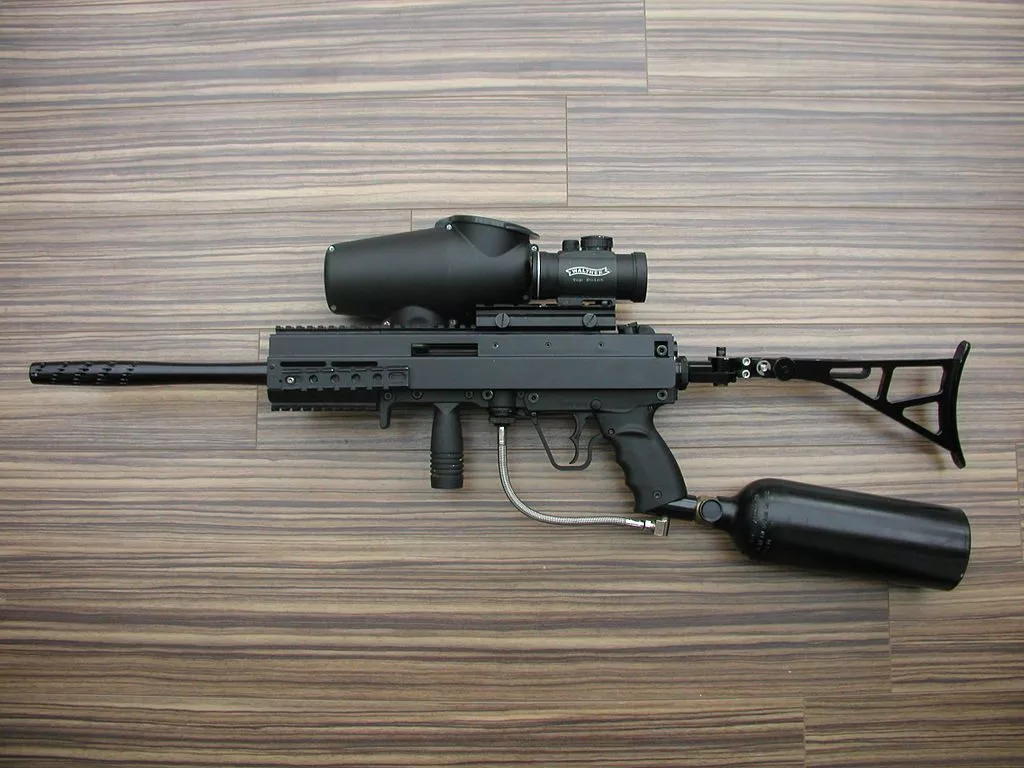Before you decide on a single gun, you’ll need to decide on a type. In this guide, we’ll look at two types: electronic vs mechanical paintball guns.
Your paintball gun is your most important piece of equipment. And that makes choosing the right one the most important decision you’ll make. At its most basic, there are three types of paintball guns:
Pump paintball guns operate with a shotgun-like pumping action to load the paintball into the chamber. They’re the simplest design with good reliability, but they’re inaccurate and slow to fire. That’s why few people use them. It’s also why we’ll ignore them for now.
Instead, we’ll explore the similarities and differences between the two most common types of markers: electronic vs mechanical paintball guns.
One is objectively better than the other, but both have their strengths and weaknesses. Let’s start by quickly exploring how each works.

How Mechanical Paintball Guns Work
Mechanical paintball guns typically are semi-automatic, which means one trigger pull fires one paintball. As their name explicitly states, they’re fully mechanized without repeated manual hand-pumping or external power sources (e.g., batteries) required.
Each trigger pull moves a sear catch, which releases a striker held under spring pressure. The spring decompresses, propelling the striker forward where it hits a valve that releases compressed air. The firing pressure pushes your paintball downfield while simultaneously blowing the striker back into its starting position, where it locks behind the sear catch until you pull the trigger again.
This is called a blowback design, and it gives you the realistic recoil action of a traditional firearm.
Popular Mechanical Paintball Guns
Advantages of Mechanical Paintball Guns
- Usually much less expensive
- Usually easier to operate
- No battery power required (no replacements or recharging)
- Easy to find replacement parts
Disadvantages of Mechanical Paintball Guns
- Less accurate and consistent
- Usually require higher air pressure to fire
- Firing speeds can vary slightly from shot to shot
- Louder
- Must be cocked before being fired

How Electronic Paintball Guns Work
Electronic paintball guns are more complicated. There are three main types, briefly described in the table below, but they all share one commonality: The mechanized trigger release used in mechanical paintball guns is replaced by a circuit-driven mechanism powered by a battery (either 9V or rechargeable).
Here are the three types of electronic paintball guns:
| Type of Electronic Paintball Gun | How It Works |
|---|---|
| Electronic Sear Trippers | Same theory as a mechanical gun except your trigger pull doesn’t mechanically move the sear catch. Instead, it powers an electronic solenoid that moves the sear catch. These guns still have blowback. |
| Pneumatic Poppet Valves | These guns still use a striker to hit a valve, releasing compressed air, except there’s no sear catch. Instead, your trigger pull tells the circuit board to fire a pneumatic ram at the air valve. You still get blowback with this design. |
| Spool Valves | Spool valve guns operate very differently. No internal parts collide or blowback, making these guns especially. They’re hard to explain with words, but this animation is great. Essentially, a circuit board moves a single tube inside the gun that extends to release compressed air from a chamber and then returns to its starting position, allowing compressed air to refill the chamber while loading another paintball into position. |
For more information on the differences between all three, check out our guide the 3 Types of Paintball Guns.
Popular Electronic Paintball Guns
Advantages of Electronic Paintball Guns
- Can fire much faster thanks to programmed firing modes
- Usually smaller and lighter
- Trigger is much lighter and requires less force to pull
- Can operate with lower pressure, meaning better air tank efficiency
- Some have no blowback for better accuracy
Disadvantages of Electronic Paintball Guns
- Much more expensive
- Much more difficult to repair
- Parts often are specific to the manufacturer or model and aren’t standardized across the industry
- Usually require HPA
- Require a power source
Key Differences Between Electronic vs Mechanical Paintball Guns
The pros and cons above tell most of the story, but let’s dive a little deeper into 5 key differences.
1. Electronic paintball guns have far more firing modes
Most mechanical paintball guns are one pull, one shot. If you want to fire five shots, you need to pull the trigger five times. That means your firing speed is limited by your finger speed.
Note that this isn’t universally true. Some mechanical guns, like the Tippmann A5, offer upgrades that give you fully-automatic mode as well. As long as you hold the trigger down, the gun keeps firing.
Electronic paintball guns are controlled by a circuit board, which basically means they have a brain. Programmers can design these circuit boards to do any number of things. For example, two common electronic gun firing modes are three-shot burst and ramping.
Three-shot burst is when each trigger pull fires three shots. In order to reach the max 15.4 shots per second, you only need to pull the trigger five times.
Ramping is a more complex mode. In this mode, your gun fire as a semi-automatic (one pull, one shot) until you reach a threshold rate, generally 5 balls per second (bps). When you reach that threshold, the gun automatically begins firing at or near the maximum rate as long as you maintain that 5 bps or hold the trigger down or fail to pull the trigger for a full second (the specific disengagement criteria depends on the type of ramping mode, which can vary by manufacturer).
2. Some electronic paintball guns have no blowback
Spool valve guns have a smooth mechanism with no blowback. This makes for an easier time firing and improved accuracy. However, some players don’t like the lack of blowback because it’s less realistic.
3. Electronic paintball guns need to be recharged
Regardless of whether an electronic gun has a 9V battery that needs to be changed or a rechargeable battery, it still needs something to power it, and that something can run out of juice. Mechanical paintball guns have no powered mechanism and will fire until they break.
4. Electronic paintball guns are more air-efficient
Refilling your tank is always annoying. With electronic guns, you refill less frequently because they require less compressed air per shot. This is a feature of their consistent air discharge, which requires less pressure to shoot. However, you’ll need to use HPA instead of CO2.
5. Electronic paintball guns generally are more expensive
The complicated circuit board and electronic components is more expensive to produce, and that means a higher price tag. Some of the top-end electronic paintball guns approach $500 whereas the best mechanical guns top out around $200.
Electronic vs Mechanical Paintball Guns: Final Thoughts
In the world of paintball, choosing between electronic and mechanical guns is a pivotal decision that hinges on numerous factors. Mechanically driven markers like the widely used Tippmann A5 are straightforward and reliable. These semi-automatic markers operate through a blowback design that imitates the recoil of a traditional firearm, offering an intuitive, battery-free experience. However, their accuracy, consistency, and firing speed can be variable.
On the flip side, electronic paintball guns, typified by models like the Planet Eclipse Etha 3, provide a more complex, yet uniquely advantageous gameplay. By replacing the mechanical trigger release with a battery-powered, circuit-driven mechanism, these markers deliver faster firing modes, greater air efficiency, and are usually lighter and smaller. They do come with their drawbacks, though, being generally costlier, harder to repair, and reliant on a power source. Hence, your choice between mechanical and electronic markers should weigh these pros and cons against your preferred playing style and budget.
Frequently Asked Questions
What are the advantages of mechanical paintball guns?
• Less expensive
• Easier to operate
• No battery required
• Easy to find parts
What are the disadvantages of mechanical paintball markers?
• Less consistent and accurate
• Louder
• Firing speeds vary slightly from shot-to-shot
• Typically requires higher air pressure
• Must be cocked before firing
What are the advantages of electronic paintball guns?
• Smaller/lighter
• Faster firing due to programmed firing modes
• Trigger is way lighter and requires less pulling force
• Operates with lower pressure, offering better air tank efficiency
• Many have better accuracy because they have no blowback
What are the disadvantages of electronic paintball guns?
• Harder to repair
• More expensive
• Parts often are specific to the manufacturer or model
• Typically require HPA
• Power source required
What are the key differences between electronic vs mechanical paintball guns?
• Electronic paintball guns have more firing modes
• Some electronic markers have no blowback
• You have to recharge electronic guns
• Electronic paintball markers are more air-efficient
• Electronic paintball guns cost more $$$






